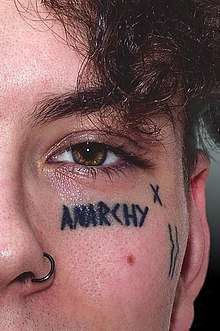Face tattoo
A facial tattoo is a tattoo located on the bearer's face or head. Taboo, socially unacceptable,[1][2] and considered extreme in body art,[3] this style and placement of tattoo has emerged in certain subcultures in recent years. This is due to the continuing acceptance of tattoos[4][5] and the emergence of hip-hop culture popularizing styles such as the teardrop tattoo. Artists such as Lil Wayne, Soulja Boy, Gucci Mane and, in recent years Post Malone, XXXTentacion, Lil Peep, Lil Skies, Lil Pump, Lil Xan and 6ix9ine contribute to its popularity.[6]

History
In Ancient Rome, slaves who fled or attempted escape from their masters would frequently be branded on their foreheads or tattooed against their will. These tattoos portrayed the crimes committed and were a punishment because of the inability to cover up a tattoo on the forehead.[7] As the Roman world entered late antiquity, extreme Christian sects began to use former-slave forehead tattoos as religious symbols and signs of strength. Religious facial and head tattoos were not socially unacceptable within these circles[8] though in the greater Roman mainstream there was still an association between face tattoos and former slavery. In 315/316 CE, an edict outlawed facial tattoos and facial branding/tattooing for slaves.[9]
Medieval pilgrims would frequently get tattoos whilst visiting the Holy Land, including the occasional face tattoo.[10][11][12] Crusaders may have got facial tattoos as permanent proof of their participation in the Crusades, although this is unknown.[13]
In ancient Vietnam, face tattooing was considered as a form of punishment. In 1042, King Ly Thai Tong issued the Hinh Thu, or Criminal Law, in which criminals were caned or tattooed 20 to 50 characters on their faces. [14]
Ethnic practices
.jpg)
Face tattoo is traditionally practiced by many ethnic groups worldwide, such as the Inuit, the Maoris, peoples of Northeast India such as the Apatani, the Chin of Myanmar and the Derung people of southwestern China.
Inuit and Alaska Natives
Facial tattoos were practiced among Inuit women, but this practice was suppressed by missionaries. In the 21st century, there was a revival of traditional facial tattooing among Indigenous Arctic women.[15][16]
Chin people

Southern Chin women were also tattooed on their faces with closely set lines using blue pigments, ostensibly to discourage them from being kidnapped by invaders.[17] Chin women were typically tattooed between the ages of 15 and 20.[18] The practice has quickly disappeared, as it was banned in the 1960s by Burma's totalitarian regime and it was discouraged by Christian missionaries.[19][20] Mro women also wore tattoos in the form of small marks or stars on the cheek, forehead or breast.[21]
Ainu
The Ainu people of northern Japan and parts of Russia, including Sakhalin, the Kuril Islands and Kamchatka Krai, have a practice of facial tattooing exclusive to women, in which a smile is inked around the mouth to prevent spirits from entering the body through the mouth. This form of tattooing also serves a secondary purpose of showing maturity.
Modern day
Presently, face tattoos are considered socially unacceptable and "outrageous"[22] and generally will prohibit the tattooed person from finding employment[23][24][25][26][27] and results in discrimination in many cases.[28][29][30] Most tattoo artists will attempt to dissuade clients from getting a facial tattoo, and in some cases may outright refuse to do a facial tattoo, but this refusal is usually done when the client has few tattoos collected on the rest of their body.[31][32][33][34]
Due to how taboo tattoos were originally, they are often associated with criminality. Many gangs and criminal organizations mark members with tattoos, including visible areas such as the face, head, and neck.[35][36][37] Members may get excessive facial tattoos as a form of intimidation.[38][39][40] This started in California in the 1980s before becoming widespread.[41]
A 2013 study published in Psychology, Public Policy, and Law concluded that face tattoos often lead to bias in the jury and more frequent convictions.[42] Many ex-convicts also have facial tattoos, due to prison tattooing, and the culture of prison tattoos includes the indoctrination of people within the prison populace into gangs, which often require tattoos to show aggression.[43][44] These tattoos include teardrop tattoos indicating that the bearer has either taken a life or lost someone close to them; a five-point crown, a common Latin Kings symbol; and a number of different facial tattoos alluding to Nazism in the Aryan Brotherhood and Salvadorian culture in MS-13.[45][46] Charles Manson infamously had a Nazi swastika tattooed on his forehead.
In the mid 2000s, the trend of getting a facial tattoo emerged among celebrities, starting with Mike Tyson's large tribal tattoo in 2003[47] and the ascension of rap music from the underground to the mainstream. This allowed artists with a criminal background and face tattoos to become well known, including Birdman, Lil Wayne and The Game.[48] Lil Wayne's excessive tattooing of his face created a minor trend that he helped pioneer[49] inspiring rappers like Gucci Mane[50] and then-chart topper Soulja Boy to get facial tattoos.[51]
Hip-hop culture
The influence of artists like Lil Wayne getting face tattoos wasn't fully realized until the mid-2010s with the resurgence of trap music and the "SoundCloud rap" scene.[52] Artists such as Lil Uzi Vert,[53] Travis Scott,[54] 21 Savage[55] and Migos[56] all have facial tattoos and emerged between 2014 and 2016, soon entering the mainstream and the Billboard Hot 100. The facial tattoos are often used by these artists as motivation to limit attaining meaningful employment, leading them to focus entirely on their music career. This, alongside with the entrance of hip-hop culture and black culture into the mainstream[57][58][59] has led to face tattoos increasing in popularity.[60]
Though discrimination remains in the fashion world for models who have facial tattoos, generally models with face tattoos of the brand they're modeling for, such as having a Chanel logo under your eye, is becoming acceptable.[61]
In professional sports
In 2003, American heavyweight professional boxer Mike Tyson received his infamous face tattoo. The iconic tribal design then went on to define his public image as the 'baddest man on the planet'.
See also
- Permanent cosmetics
References
- "'I lost a job because of my tattoos'". BBC News. 2014-09-22. Retrieved 2018-10-23.
- "Why Many Tattoo Artists Won't Ink Hands, Feet, or Faces". LiveAbout. Retrieved 2018-10-23.
- "Face Tattoos Go Mainstream". Retrieved 2018-10-23.
- Prescott, Autumn. "Tattoos should not be taboo in society". The Eclipse. Retrieved 2018-10-23.
- "So why do 'normal' people get tattoos?". 2007-10-09. Retrieved 2018-10-23.
- "The future has a face tattoo". The Outline. Retrieved 2018-10-23.
- Jones, C. P. (1987). "Stigma: Tattooing and Branding in Graeco-Roman Antiquity". The Journal of Roman Studies. 77: 139–155. doi:10.2307/300578. JSTOR 300578.
- Bond, Sarah. "Tattoo Taboo? Exploring The History Of Religious Ink And Facial Tattoos". Forbes. Retrieved 2018-10-23.
- "IMPERATORIS THEODOSII CODEX liber nonus". ancientrome.ru. Retrieved 2018-10-23.
- "Inside the World's Only Surviving Tattoo Shop For Medieval Pilgrims". Atlas Obscura. 2016-08-18. Retrieved 2018-10-23.
- Lewy, Mordechay. "Jerusalem under the skin - pilgrim tattoos promoted by the Franciscans in the Holy Land.ppt". Cite journal requires
|journal=(help) - Kristensen, Troels Myrup. "Textiles, Tattoos and the Representation of Pilgrimage in the Roman and Early Christian Periods (2012)". HEROM 1: The Material Culture of Roman and Early Christian Pilgrimage, Pp. 107-134.
- "Center for Tattoo History and Culture". Center for Tattoo History and Culture. Retrieved 2018-10-23.
- Donald G, Mccloud (2018). Southeast Asia: Tradition And Modernity In The Contemporary World, Second Edition. Routledge. ISBN 9780813318967.
- Hughes, Zachariah; Media, Alaska Public (2015-09-18). "More than ink: Traditional tattoos roar back in Alaska". Alaska Public Media. Retrieved 2019-10-29.
- Allford, Jennifer (2019-10-23). "Reclaiming Inuit culture, one tattoo at a time". Retrieved 2020-01-14.
- White, Herbert Thirkell (2011). Burma. Cambridge University Press. ISBN 9781107600676.
- Myo Myo. "A symbol of Chin identity fades away". Myanmar Times. Archived from the original on 14 February 2013. Retrieved 27 September 2013.
- "Tattooed Chin women lure tourists to remote region". Myanmar Times. 25 April 2011. Archived from the original on 8 October 2013. Retrieved 27 September 2013.
- Nyein Ei Ei Htwe (17 November 2013). "Chin tattoos: a fading tradition". Myanmar Times. Retrieved 1 July 2015.
- Gait, Edward Albert (1902). Census of India, 1901. 12. Office of the Superintendent of Government Printing.
- "Ever Wonder Why People Get Face Tattoos? Here's The Answer From 9 People Who Did". HuffPost UK. 2013-09-06. Retrieved 2018-10-23.
- "Tattooed People May Be More Likely to Find Employment". Loudwire. Retrieved 2018-10-23.
- "Research reveals how your tattoos affect your chances of getting the job - Workopolis Blog". Workopolis Blog. 2014-10-06. Retrieved 2018-10-23.
- "Can a Tattoo Really Cost You a Job?". SalesHQ. Retrieved 2018-10-23.
- "Discrimination against tattoos in the workplace- Attwells Solicitors LLP". Attwells Solicitors LLP. Retrieved 2018-10-23.
- "YouGov | That inking feeling: the tattoos employers don't want to see". YouGov: What the world thinks. Retrieved 2018-10-23.
- Kelly, Jon (2014-08-18). "Should anti-tattoo discrimination be illegal?". BBC News. Retrieved 2018-10-23.
- "You want a good job – but you also want a facial tattoo. What should you do?". the Guardian. 2018-06-10. Retrieved 2018-10-23.
- "Dress codes, tattoos, piercings and discrimination - QCS". QCS. 2017-03-16. Retrieved 2018-10-23.
- "Tattoos That Tattoo Artists Refuse To Do". 2018-04-06. Retrieved 2018-10-23.
- Codrea-Rado, Anna (2015-08-09). "Are tattoo artists right to refuse to adorn necks and hands?". the Guardian. Retrieved 2018-10-23.
- "Neck Tattoos, And Why Your Artist Won't..." Tattoodo. Retrieved 2018-10-23.
- "Tattoos many tattoo artists hate to do". TheList.com. Retrieved 2018-10-23.
- "A statistical analysis of the art on convicts' bodies". The Economist. Retrieved 2018-10-23.
- WRAL. "Blink and you won't miss it: Face tattoos go mainstream :: WRAL.com". WRAL.com. Retrieved 2018-10-23.
- "Hip-Hop Ink: Gang Tattoos Explained". HotNewHipHop. Retrieved 2018-10-23.
- Nelson, Patrick (2017-11-30). "Face tattoos a trend for Valley crime suspects". YOURCENTRALVALLEY. Retrieved 2018-10-23.
- "(PDF) Inked into Crime? An Examination of the Causal Relationship between Tattoos and Life-Course Offending among Males from the Cambridge Study in Delinquent Development". ResearchGate. Retrieved 2018-10-23.
- https://academicworks.cuny.edu/cgi/viewcontent.cgi?article=1012&context=jj_etds
- "Where All the Madness Began: A Look at Gang History". web.stanford.edu. Retrieved 2018-10-23.
- Funk, Friederike; Todorov, Alexander (2013). "Criminal stereotypes in the courtroom: Facial tattoos affect guilt and punishment differently". Psychology, Public Policy, and Law. 19 (4): 466–478. doi:10.1037/a0034736. ISSN 1939-1528.
- "15 common prison tattoos and what they mean". Business Insider. Retrieved 2018-10-23.
- "Another inmate with a tattooed face escapes". The Mercury News. 2017-11-28. Retrieved 2018-10-23.
- "7 Most Notorious Prison Tattoos & What They Mean". RealClear. Retrieved 2018-10-23.
- "Hate on Display™ Hate Symbols Database". Anti-Defamation League. Retrieved 2018-10-23.
- "Mike Tyson sees no downside to his face tattoo". SI.com. Retrieved 2018-10-23.
- "A Guide to Celebrity Face TattoosLil Wayne". Complex. Retrieved 2018-10-23.
- Tijerina, Daniela (2018-07-31). "Face-Tat Fever". Rolling Stone. Retrieved 2018-10-23.
- Perpetua, Matthew (2011-01-13). "What Does Gucci Mane's Ice Cream Cone Tattoo Mean?". Rolling Stone. Retrieved 2018-10-23.
- "Soulja Boy Says Goodbye To The Gucci Logo Tattoo On His Forehead". Vibe. 2015-12-28. Retrieved 2018-10-23.
- "Rappers Break Down Lil Wayne's Lasting Impact". PigeonsandPlanes. Retrieved 2018-10-23.
- "Lil Uzi Vert Got His First Face Tattoo So He'd Have To Focus On Music". HotNewHipHop. Retrieved 2018-10-23.
- "Travis Scott Shows Off New Face Tattoo - XXL". XXL Mag. Retrieved 2018-10-23.
- "The Brutal Story Behind 21 Savage's Dagger Face Tattoo". DJBooth. Retrieved 2018-10-23.
- http://hiphopdx.com, HipHopDX -. "HipHopDX's Handy Guide For Telling The Migos Apart". HipHopDX. Retrieved 2018-10-23.
- "Hip-Hop: From the Streets to the Mainstream - IIP Publications". IIP Publications. Retrieved 2018-10-23.
- Petridis, Alexis (2003-10-08). "Feature: Hip-hop has taken over mainstream pop culture". the Guardian. Retrieved 2018-10-23.
- "How Rap Became the Sound of the Mainstream". Time. Retrieved 2018-10-23.
- "The future has a face tattoo". The Outline. Retrieved 2018-10-23.
- "face tattoos in fashion: a controversial history". I-d. 2016-09-30. Retrieved 2018-10-23.